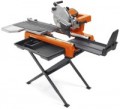Power
Rated motor power of the electric tile cutter. The more powerful the engine — the more force it can give to the cutting tool, the higher the rotation speed and disc diameter can be. Accordingly, a more
powerful tool is better suited for larger jobs and hard and/or thick materials. On the other hand, high power significantly affects the price, dimensions and weight of the tool, despite the fact that there is not always a real need for it.
In light of all this, it is necessary to choose a tile cutter in terms of power, taking into account the specifics of the intended use. So, in the case of a hand tool for simple household work, a power of 700 – 800 W is enough, more solid indicators may be required mainly for professional use. But in stationary units, where compactness does not really matter, you can not save on power — especially since such devices are usually used where performance is important.
Rotation speed
The maximum disc rotation speed provided by the motor of the electric tile cutter. Higher speeds are good for productivity, clean cuts and the ability to handle difficult materials, but they also require the right amount of power.
In general, if a tile cutter is bought for simple work with ordinary facing tiles (for example, repairs in an apartment), you can not pay much attention to this indicator: even the “slowest” models provide enough speed to cope with such tasks. But for cutting specific materials (for example, some types of stone), higher speeds may be required; detailed recommendations on this issue can be found in special sources.
Cutting length
The longest cut that can be made with a tile cutter.
This parameter is relevant primarily for manual tile cutters, as well as for electric stationary units with a top disc feed. In such tools, the cutting element moves along the guide rail and has limited space for movement, and the length of the cut is, in fact, the length of the stroke of the cutting tool from one extreme point to the other. In fact, this is the maximum width of the material that can be cut with a tile cutter.
Cutting depth
The greatest depth to which the tool can cut through the material being processed, in other words, the maximum thickness of the tile that the tile cutter is guaranteed to be able to cut.
It is worth choosing a tool for this parameter taking into account the thickness of the material with which to work, plus some margin “just in case”. But this margin should not be too large: for a
deep cut, large discs and high power are required, which accordingly affects the price, weight and dimensions of the tool.
Side platform
The presence of
a side platform in the design of the tile cutter.
Such a platform is found mainly in electrical stationary units (see "Type"). It looks like a small platform, "extending" the main working platform to the side of the cutting line. This provides additional support for the cut tile, which is especially important when cutting large pieces: without a side platform, such fragments have to be supported by hand in order to avoid falling and damage, and this is not very convenient.
Transportation wheels
The presence of
transport rollers in the design of the tile cutter — small wheels for transportation from place to place.
This feature is found exclusively in electric stationary models (see "Type"): the weight of such units is estimated at tens of kilograms, and it would be very difficult to carry them on weight. In turn, the transport rollers allow one person to roll the tile cutter without much difficulty. At the same time, the design of the rollers is chosen in such a way that they do not affect the stability of the unit in the working position: for example, in some models the wheels can be removable, in others they are located only on one side, and to support the wheels, the unit must be raised in the manner of a garden wheelbarrow , etc.
Noise level
The average noise level produced by the tile cutter during operation. Actual figures may differ from those claimed in any direction, depending on the specific material, speed of work, wear of the cutting blade, etc. However, in general, according to this indicator, it is quite possible to evaluate the loudness of the unit.
The lower the noise level, the more comfortable the work with the tile cutter, the lower the fatigue. The quietest of modern instruments give out about 60 dB — this is the level of a loud conversation at a distance of about 1 m; in the most noisy, the volume exceeds 100 dB (sound background in an industrial workshop).

